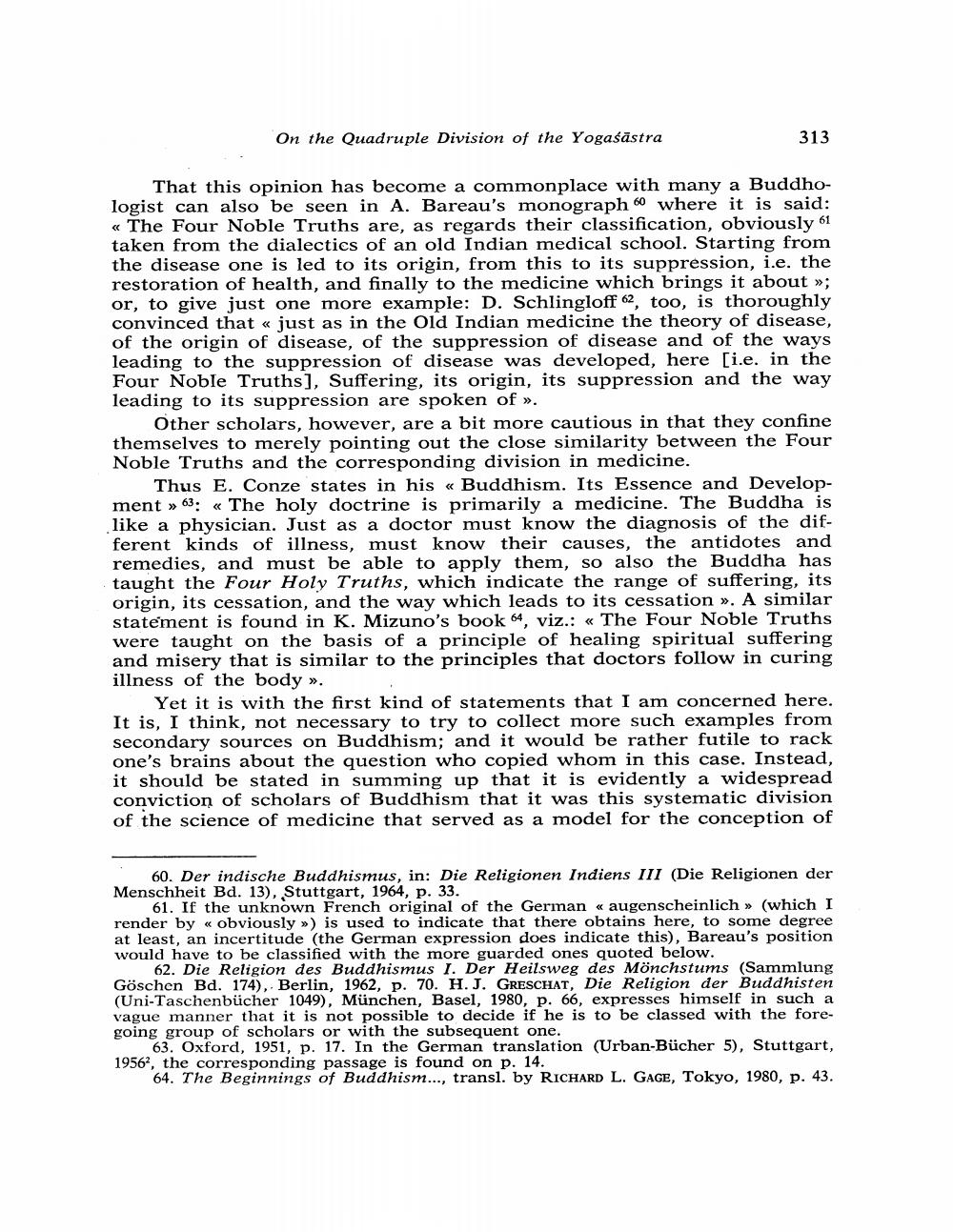________________
313
On the Quadruple Division of the Yogaśāstra
That this opinion has become a commonplace with many a Buddhologist can also be seen in A. Bareau's monograph 60 where it is said: << The Four Noble Truths are, as regards their classification, obviously 61 taken from the dialectics of an old Indian medical school. Starting from the disease one is led to its origin, from this to its suppression, i.e. the restoration of health, and finally to the medicine which brings it about >>; or, to give just one more example: D. Schlingloff 62, too, is thoroughly convinced that << just as in the Old Indian medicine the theory of disease, of the origin of disease, of the suppression of disease and of the ways leading to the suppression of disease was developed, here [i.e. in the Four Noble Truths], Suffering, its origin, its suppression and the way leading to its suppression are spoken of ».
Other scholars, however, are a bit more cautious in that they confine themselves to merely pointing out the close similarity between the Four Noble Truths and the corresponding division in medicine.
Thus E. Conze states in his « Buddhism. Its Essence and Development » 63: « The holy doctrine is primarily a medicine. The Buddha is like a physician. Just as a doctor must know the diagnosis of the different kinds of illness, must know their causes, the antidotes and remedies, and must be able to apply them, so also the Buddha has taught the Four Holy Truths, which indicate the range of suffering, its origin, its cessation, and the way which leads to its cessation ». A similar statement is found in K. Mizuno's book 64, viz.: « The Four Noble Truths were taught on the basis of a principle of healing spiritual suffering and misery that is similar to the principles that doctors follow in curing illness of the body »>.
Yet it is with the first kind of statements that I am concerned here. It is, I think, not necessary to try to collect more such examples from secondary sources on Buddhism; and it would be rather futile to rack one's brains about the question who copied whom in this case. Instead, it should be stated in summing up that it is evidently a widespread conviction of scholars of Buddhism that it was this systematic division of the science of medicine that served as a model for the conception of
60. Der indische Buddhismus, in: Die Religionen Indiens III (Die Religionen der Menschheit Bd. 13), Stuttgart, 1964, p. 33.
61. If the unknown French original of the German « augenscheinlich »> (which I render by « obviously ») is used to indicate that there obtains here, to some degree at least, an incertitude (the German expression does indicate this), Bareau's position would have to be classified with the more guarded ones quoted below.
62. Die Religion des Buddhismus I. Der Heilsweg des Mönchstums (Sammlung Göschen Bd. 174), Berlin, 1962, p. 70. H. J. GRESCHAT, Die Religion der Buddhisten (Uni-Taschenbücher 1049), München, Basel, 1980, p. 66, expresses himself in such a vague manner that it is not possible to decide if he is to be classed with the foregoing group of scholars or with the subsequent one.
63. Oxford, 1951, p. 17. In the German translation (Urban-Bücher 5), Stuttgart, 19562, the corresponding passage is found on p. 14.
64. The Beginnings of Buddhism..., transl. by RICHARD L. GAGE, Tokyo, 1980, p. 43.




